Toowoomba Clubhouse: Knowledge Management & Organizational Learning
VerifiedAdded on 2021/05/30
|10
|2570
|154
Report
AI Summary
This report analyzes the application of knowledge management and organizational learning principles at Toowoomba Clubhouse, contextualizing them within the theoretical framework of learning organizations. The report examines six interactional elements of a learning organization, assessing whether Toowoomba Clubhouse fits this model by analyzing its leadership, team-based structure, employee empowerment, open information sharing, participative strategy, and strong culture. The study also explores the four units of learning – knowledge sharing, capture, discovery, and application – and how Toowoomba Clubhouse can gain knowledge through each. Furthermore, it discusses how the organization can strategically utilize knowledge management systems, including the benefits and risks of using technology for capturing, organizing, storing, and sharing knowledge. Finally, the report provides recommendations for developing a knowledge-sharing culture to enhance knowledge management and organizational learning within the organization.
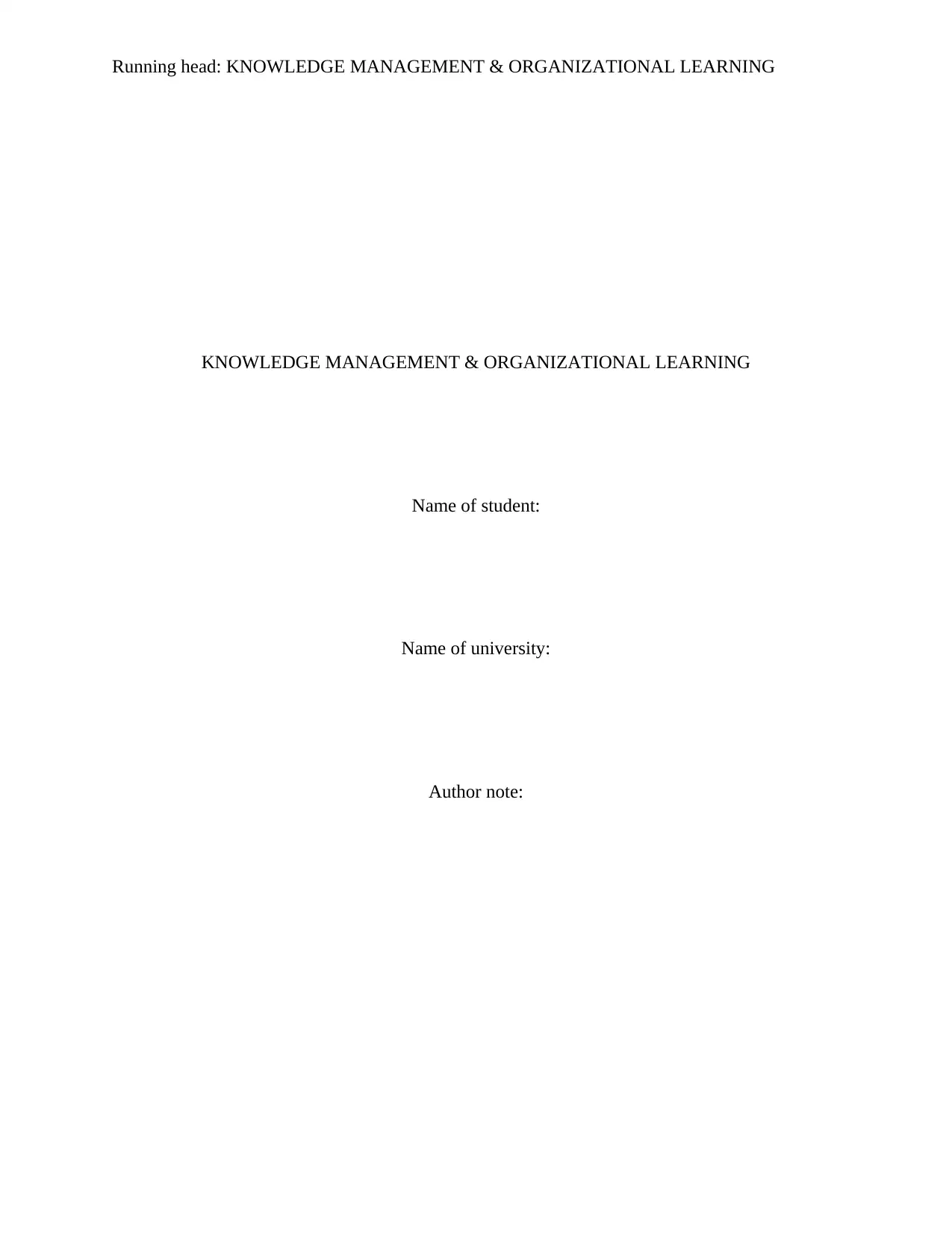
Running head: KNOWLEDGE MANAGEMENT & ORGANIZATIONAL LEARNING
KNOWLEDGE MANAGEMENT & ORGANIZATIONAL LEARNING
Name of student:
Name of university:
Author note:
KNOWLEDGE MANAGEMENT & ORGANIZATIONAL LEARNING
Name of student:
Name of university:
Author note:
Paraphrase This Document
Need a fresh take? Get an instant paraphrase of this document with our AI Paraphraser
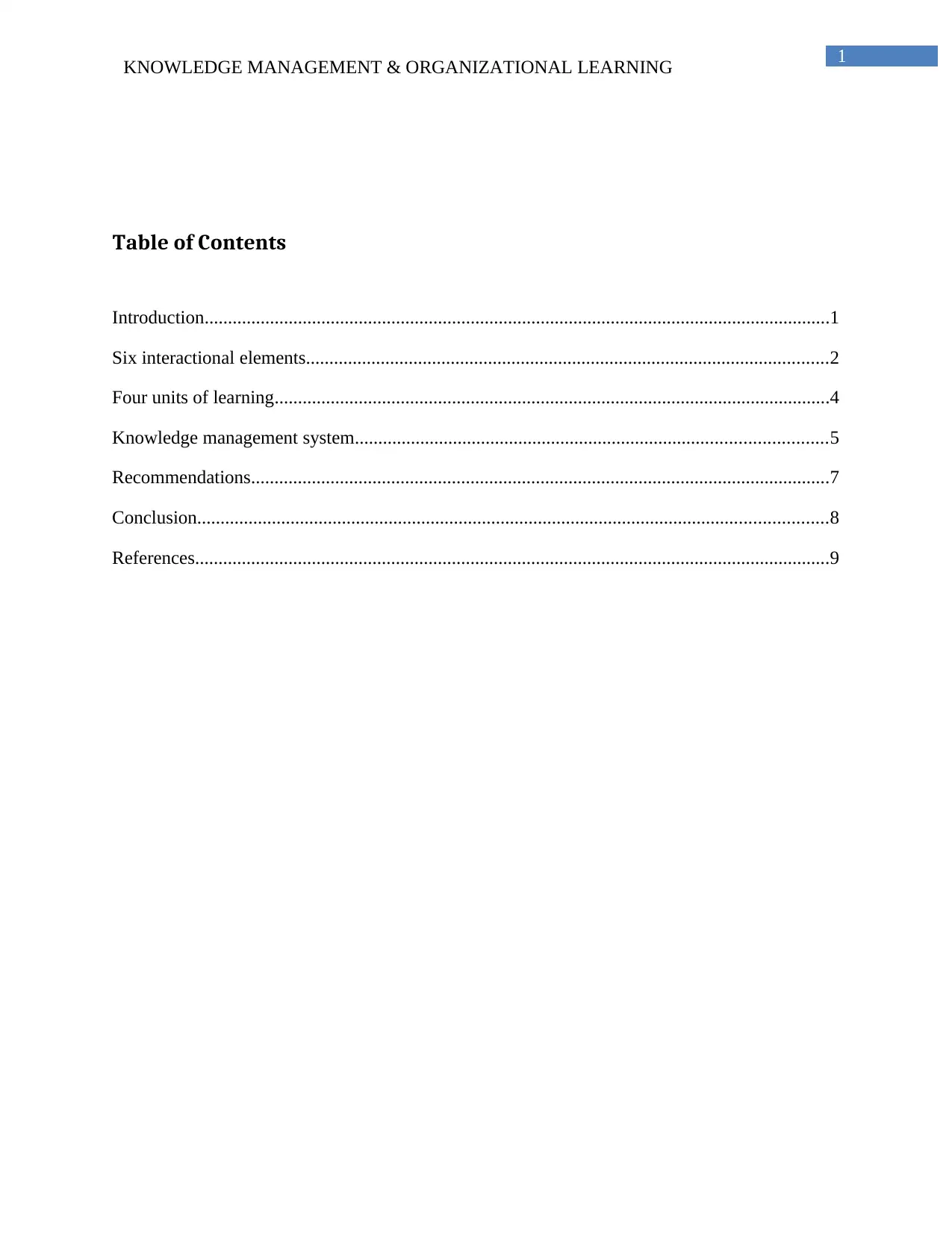
1
KNOWLEDGE MANAGEMENT & ORGANIZATIONAL LEARNING
Table of Contents
Introduction......................................................................................................................................1
Six interactional elements................................................................................................................2
Four units of learning.......................................................................................................................4
Knowledge management system.....................................................................................................5
Recommendations............................................................................................................................7
Conclusion.......................................................................................................................................8
References........................................................................................................................................9
KNOWLEDGE MANAGEMENT & ORGANIZATIONAL LEARNING
Table of Contents
Introduction......................................................................................................................................1
Six interactional elements................................................................................................................2
Four units of learning.......................................................................................................................4
Knowledge management system.....................................................................................................5
Recommendations............................................................................................................................7
Conclusion.......................................................................................................................................8
References........................................................................................................................................9
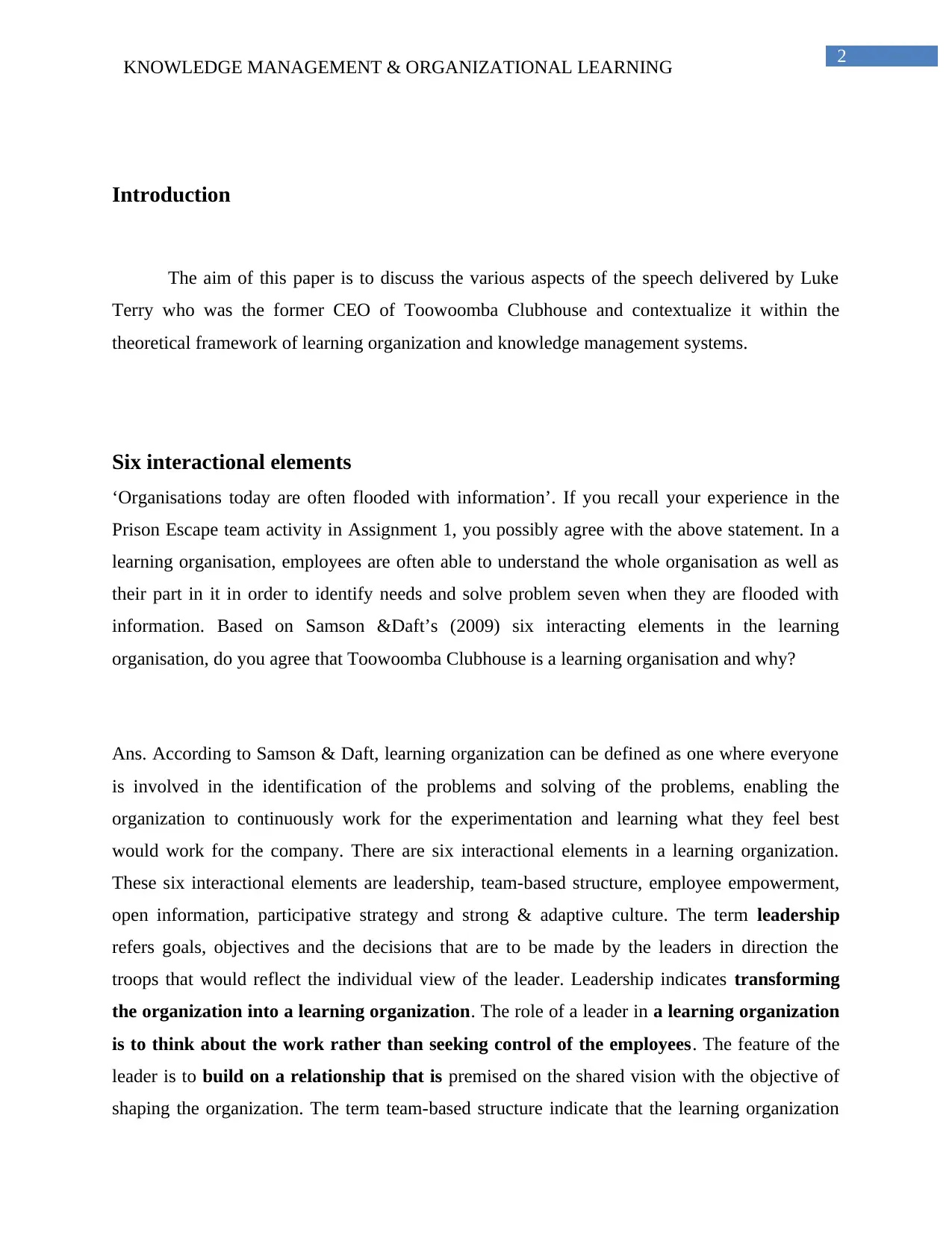
2
KNOWLEDGE MANAGEMENT & ORGANIZATIONAL LEARNING
Introduction
The aim of this paper is to discuss the various aspects of the speech delivered by Luke
Terry who was the former CEO of Toowoomba Clubhouse and contextualize it within the
theoretical framework of learning organization and knowledge management systems.
Six interactional elements
‘Organisations today are often flooded with information’. If you recall your experience in the
Prison Escape team activity in Assignment 1, you possibly agree with the above statement. In a
learning organisation, employees are often able to understand the whole organisation as well as
their part in it in order to identify needs and solve problem seven when they are flooded with
information. Based on Samson &Daft’s (2009) six interacting elements in the learning
organisation, do you agree that Toowoomba Clubhouse is a learning organisation and why?
Ans. According to Samson & Daft, learning organization can be defined as one where everyone
is involved in the identification of the problems and solving of the problems, enabling the
organization to continuously work for the experimentation and learning what they feel best
would work for the company. There are six interactional elements in a learning organization.
These six interactional elements are leadership, team-based structure, employee empowerment,
open information, participative strategy and strong & adaptive culture. The term leadership
refers goals, objectives and the decisions that are to be made by the leaders in direction the
troops that would reflect the individual view of the leader. Leadership indicates transforming
the organization into a learning organization. The role of a leader in a learning organization
is to think about the work rather than seeking control of the employees. The feature of the
leader is to build on a relationship that is premised on the shared vision with the objective of
shaping the organization. The term team-based structure indicate that the learning organization
KNOWLEDGE MANAGEMENT & ORGANIZATIONAL LEARNING
Introduction
The aim of this paper is to discuss the various aspects of the speech delivered by Luke
Terry who was the former CEO of Toowoomba Clubhouse and contextualize it within the
theoretical framework of learning organization and knowledge management systems.
Six interactional elements
‘Organisations today are often flooded with information’. If you recall your experience in the
Prison Escape team activity in Assignment 1, you possibly agree with the above statement. In a
learning organisation, employees are often able to understand the whole organisation as well as
their part in it in order to identify needs and solve problem seven when they are flooded with
information. Based on Samson &Daft’s (2009) six interacting elements in the learning
organisation, do you agree that Toowoomba Clubhouse is a learning organisation and why?
Ans. According to Samson & Daft, learning organization can be defined as one where everyone
is involved in the identification of the problems and solving of the problems, enabling the
organization to continuously work for the experimentation and learning what they feel best
would work for the company. There are six interactional elements in a learning organization.
These six interactional elements are leadership, team-based structure, employee empowerment,
open information, participative strategy and strong & adaptive culture. The term leadership
refers goals, objectives and the decisions that are to be made by the leaders in direction the
troops that would reflect the individual view of the leader. Leadership indicates transforming
the organization into a learning organization. The role of a leader in a learning organization
is to think about the work rather than seeking control of the employees. The feature of the
leader is to build on a relationship that is premised on the shared vision with the objective of
shaping the organization. The term team-based structure indicate that the learning organization
⊘ This is a preview!⊘
Do you want full access?
Subscribe today to unlock all pages.

Trusted by 1+ million students worldwide
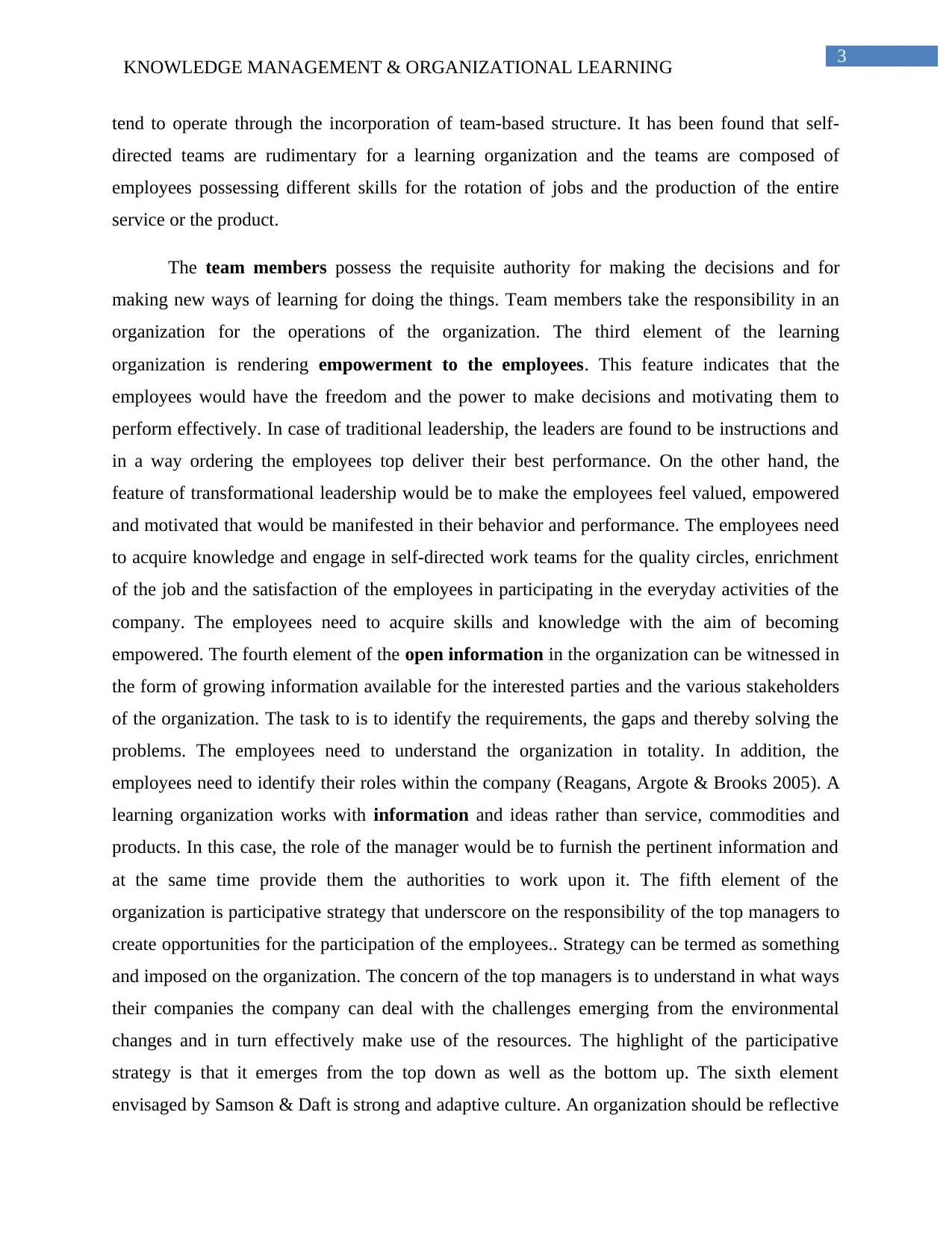
3
KNOWLEDGE MANAGEMENT & ORGANIZATIONAL LEARNING
tend to operate through the incorporation of team-based structure. It has been found that self-
directed teams are rudimentary for a learning organization and the teams are composed of
employees possessing different skills for the rotation of jobs and the production of the entire
service or the product.
The team members possess the requisite authority for making the decisions and for
making new ways of learning for doing the things. Team members take the responsibility in an
organization for the operations of the organization. The third element of the learning
organization is rendering empowerment to the employees. This feature indicates that the
employees would have the freedom and the power to make decisions and motivating them to
perform effectively. In case of traditional leadership, the leaders are found to be instructions and
in a way ordering the employees top deliver their best performance. On the other hand, the
feature of transformational leadership would be to make the employees feel valued, empowered
and motivated that would be manifested in their behavior and performance. The employees need
to acquire knowledge and engage in self-directed work teams for the quality circles, enrichment
of the job and the satisfaction of the employees in participating in the everyday activities of the
company. The employees need to acquire skills and knowledge with the aim of becoming
empowered. The fourth element of the open information in the organization can be witnessed in
the form of growing information available for the interested parties and the various stakeholders
of the organization. The task to is to identify the requirements, the gaps and thereby solving the
problems. The employees need to understand the organization in totality. In addition, the
employees need to identify their roles within the company (Reagans, Argote & Brooks 2005). A
learning organization works with information and ideas rather than service, commodities and
products. In this case, the role of the manager would be to furnish the pertinent information and
at the same time provide them the authorities to work upon it. The fifth element of the
organization is participative strategy that underscore on the responsibility of the top managers to
create opportunities for the participation of the employees.. Strategy can be termed as something
and imposed on the organization. The concern of the top managers is to understand in what ways
their companies the company can deal with the challenges emerging from the environmental
changes and in turn effectively make use of the resources. The highlight of the participative
strategy is that it emerges from the top down as well as the bottom up. The sixth element
envisaged by Samson & Daft is strong and adaptive culture. An organization should be reflective
KNOWLEDGE MANAGEMENT & ORGANIZATIONAL LEARNING
tend to operate through the incorporation of team-based structure. It has been found that self-
directed teams are rudimentary for a learning organization and the teams are composed of
employees possessing different skills for the rotation of jobs and the production of the entire
service or the product.
The team members possess the requisite authority for making the decisions and for
making new ways of learning for doing the things. Team members take the responsibility in an
organization for the operations of the organization. The third element of the learning
organization is rendering empowerment to the employees. This feature indicates that the
employees would have the freedom and the power to make decisions and motivating them to
perform effectively. In case of traditional leadership, the leaders are found to be instructions and
in a way ordering the employees top deliver their best performance. On the other hand, the
feature of transformational leadership would be to make the employees feel valued, empowered
and motivated that would be manifested in their behavior and performance. The employees need
to acquire knowledge and engage in self-directed work teams for the quality circles, enrichment
of the job and the satisfaction of the employees in participating in the everyday activities of the
company. The employees need to acquire skills and knowledge with the aim of becoming
empowered. The fourth element of the open information in the organization can be witnessed in
the form of growing information available for the interested parties and the various stakeholders
of the organization. The task to is to identify the requirements, the gaps and thereby solving the
problems. The employees need to understand the organization in totality. In addition, the
employees need to identify their roles within the company (Reagans, Argote & Brooks 2005). A
learning organization works with information and ideas rather than service, commodities and
products. In this case, the role of the manager would be to furnish the pertinent information and
at the same time provide them the authorities to work upon it. The fifth element of the
organization is participative strategy that underscore on the responsibility of the top managers to
create opportunities for the participation of the employees.. Strategy can be termed as something
and imposed on the organization. The concern of the top managers is to understand in what ways
their companies the company can deal with the challenges emerging from the environmental
changes and in turn effectively make use of the resources. The highlight of the participative
strategy is that it emerges from the top down as well as the bottom up. The sixth element
envisaged by Samson & Daft is strong and adaptive culture. An organization should be reflective
Paraphrase This Document
Need a fresh take? Get an instant paraphrase of this document with our AI Paraphraser
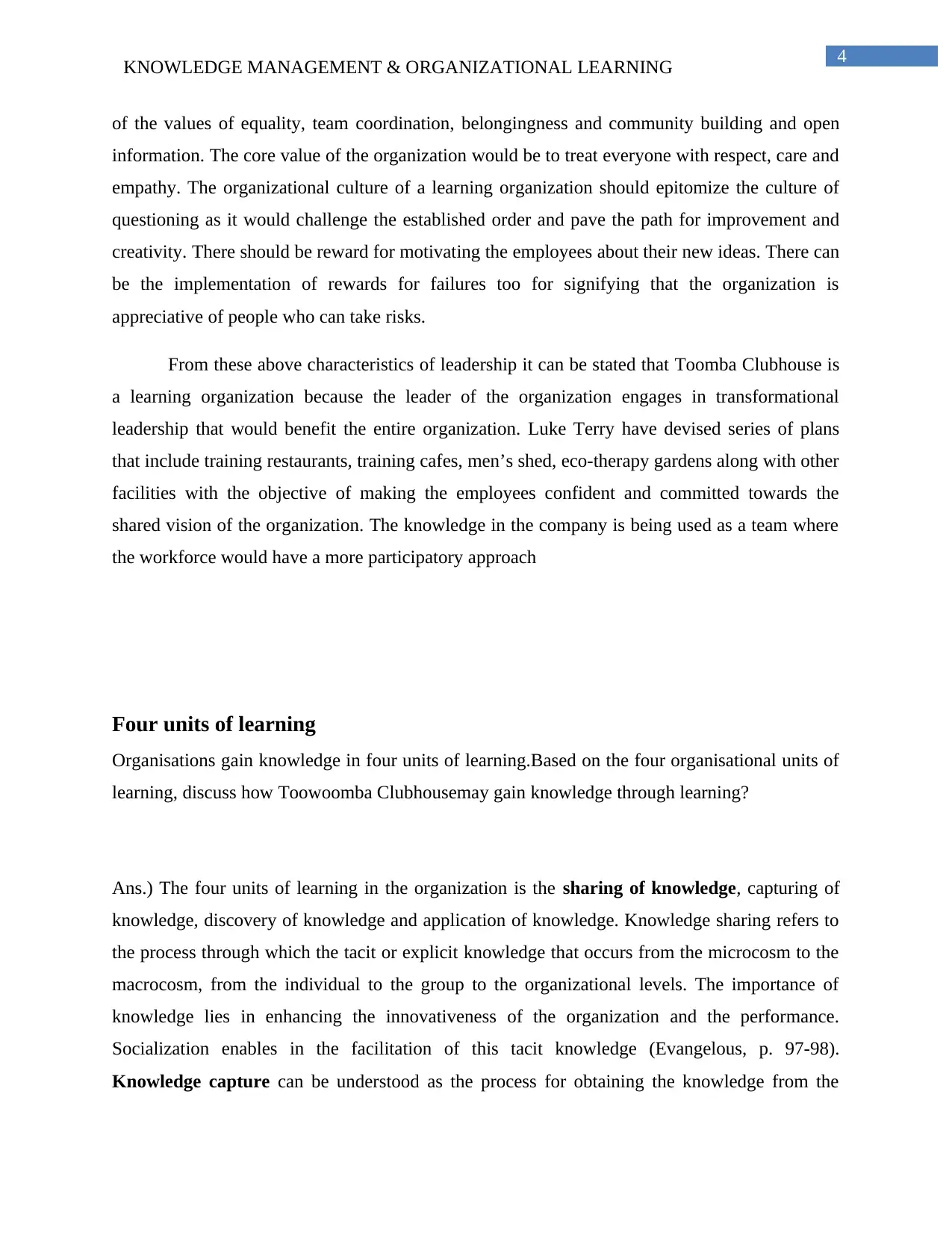
4
KNOWLEDGE MANAGEMENT & ORGANIZATIONAL LEARNING
of the values of equality, team coordination, belongingness and community building and open
information. The core value of the organization would be to treat everyone with respect, care and
empathy. The organizational culture of a learning organization should epitomize the culture of
questioning as it would challenge the established order and pave the path for improvement and
creativity. There should be reward for motivating the employees about their new ideas. There can
be the implementation of rewards for failures too for signifying that the organization is
appreciative of people who can take risks.
From these above characteristics of leadership it can be stated that Toomba Clubhouse is
a learning organization because the leader of the organization engages in transformational
leadership that would benefit the entire organization. Luke Terry have devised series of plans
that include training restaurants, training cafes, men’s shed, eco-therapy gardens along with other
facilities with the objective of making the employees confident and committed towards the
shared vision of the organization. The knowledge in the company is being used as a team where
the workforce would have a more participatory approach
Four units of learning
Organisations gain knowledge in four units of learning.Based on the four organisational units of
learning, discuss how Toowoomba Clubhousemay gain knowledge through learning?
Ans.) The four units of learning in the organization is the sharing of knowledge, capturing of
knowledge, discovery of knowledge and application of knowledge. Knowledge sharing refers to
the process through which the tacit or explicit knowledge that occurs from the microcosm to the
macrocosm, from the individual to the group to the organizational levels. The importance of
knowledge lies in enhancing the innovativeness of the organization and the performance.
Socialization enables in the facilitation of this tacit knowledge (Evangelous, p. 97-98).
Knowledge capture can be understood as the process for obtaining the knowledge from the
KNOWLEDGE MANAGEMENT & ORGANIZATIONAL LEARNING
of the values of equality, team coordination, belongingness and community building and open
information. The core value of the organization would be to treat everyone with respect, care and
empathy. The organizational culture of a learning organization should epitomize the culture of
questioning as it would challenge the established order and pave the path for improvement and
creativity. There should be reward for motivating the employees about their new ideas. There can
be the implementation of rewards for failures too for signifying that the organization is
appreciative of people who can take risks.
From these above characteristics of leadership it can be stated that Toomba Clubhouse is
a learning organization because the leader of the organization engages in transformational
leadership that would benefit the entire organization. Luke Terry have devised series of plans
that include training restaurants, training cafes, men’s shed, eco-therapy gardens along with other
facilities with the objective of making the employees confident and committed towards the
shared vision of the organization. The knowledge in the company is being used as a team where
the workforce would have a more participatory approach
Four units of learning
Organisations gain knowledge in four units of learning.Based on the four organisational units of
learning, discuss how Toowoomba Clubhousemay gain knowledge through learning?
Ans.) The four units of learning in the organization is the sharing of knowledge, capturing of
knowledge, discovery of knowledge and application of knowledge. Knowledge sharing refers to
the process through which the tacit or explicit knowledge that occurs from the microcosm to the
macrocosm, from the individual to the group to the organizational levels. The importance of
knowledge lies in enhancing the innovativeness of the organization and the performance.
Socialization enables in the facilitation of this tacit knowledge (Evangelous, p. 97-98).
Knowledge capture can be understood as the process for obtaining the knowledge from the
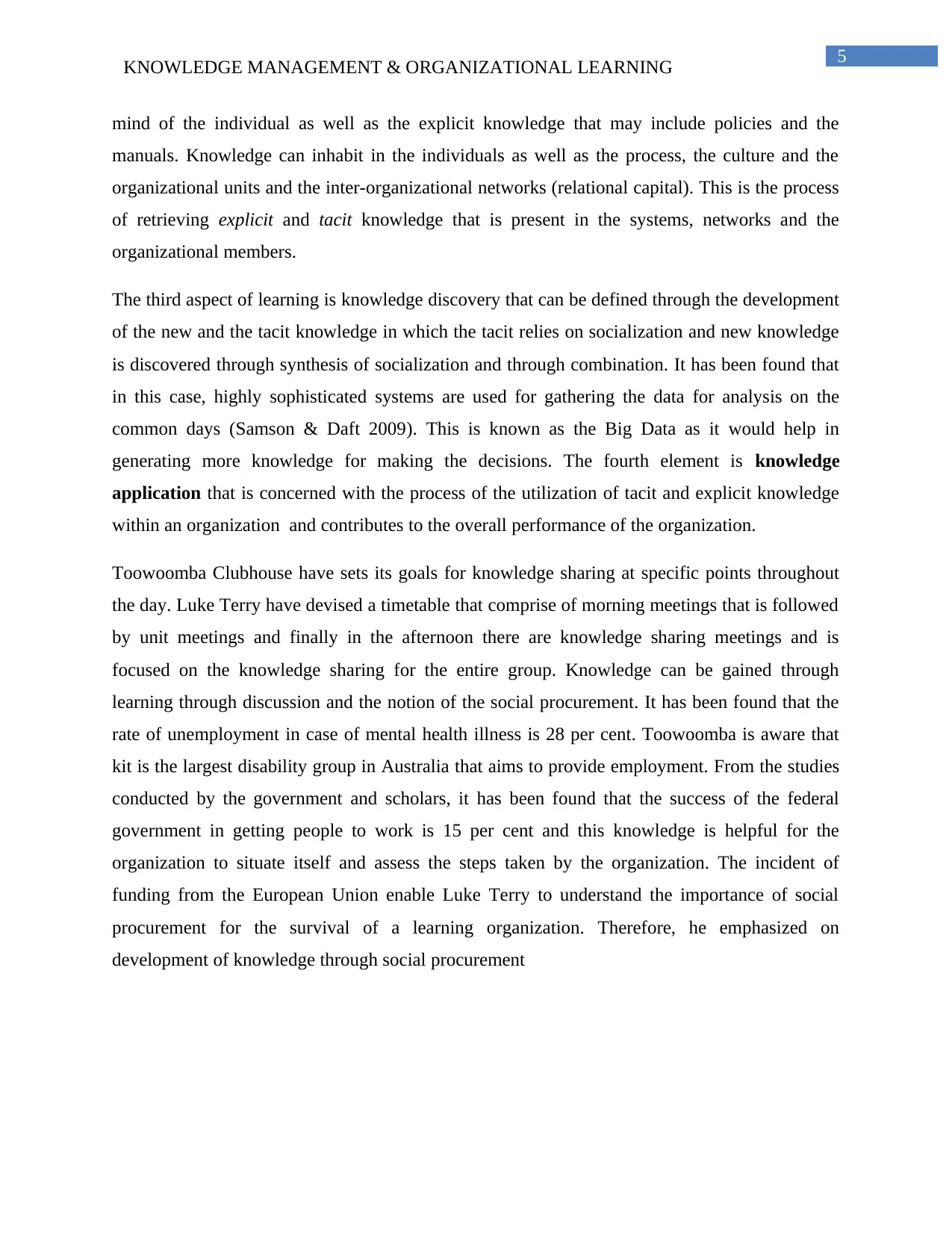
5
KNOWLEDGE MANAGEMENT & ORGANIZATIONAL LEARNING
mind of the individual as well as the explicit knowledge that may include policies and the
manuals. Knowledge can inhabit in the individuals as well as the process, the culture and the
organizational units and the inter-organizational networks (relational capital). This is the process
of retrieving explicit and tacit knowledge that is present in the systems, networks and the
organizational members.
The third aspect of learning is knowledge discovery that can be defined through the development
of the new and the tacit knowledge in which the tacit relies on socialization and new knowledge
is discovered through synthesis of socialization and through combination. It has been found that
in this case, highly sophisticated systems are used for gathering the data for analysis on the
common days (Samson & Daft 2009). This is known as the Big Data as it would help in
generating more knowledge for making the decisions. The fourth element is knowledge
application that is concerned with the process of the utilization of tacit and explicit knowledge
within an organization and contributes to the overall performance of the organization.
Toowoomba Clubhouse have sets its goals for knowledge sharing at specific points throughout
the day. Luke Terry have devised a timetable that comprise of morning meetings that is followed
by unit meetings and finally in the afternoon there are knowledge sharing meetings and is
focused on the knowledge sharing for the entire group. Knowledge can be gained through
learning through discussion and the notion of the social procurement. It has been found that the
rate of unemployment in case of mental health illness is 28 per cent. Toowoomba is aware that
kit is the largest disability group in Australia that aims to provide employment. From the studies
conducted by the government and scholars, it has been found that the success of the federal
government in getting people to work is 15 per cent and this knowledge is helpful for the
organization to situate itself and assess the steps taken by the organization. The incident of
funding from the European Union enable Luke Terry to understand the importance of social
procurement for the survival of a learning organization. Therefore, he emphasized on
development of knowledge through social procurement
KNOWLEDGE MANAGEMENT & ORGANIZATIONAL LEARNING
mind of the individual as well as the explicit knowledge that may include policies and the
manuals. Knowledge can inhabit in the individuals as well as the process, the culture and the
organizational units and the inter-organizational networks (relational capital). This is the process
of retrieving explicit and tacit knowledge that is present in the systems, networks and the
organizational members.
The third aspect of learning is knowledge discovery that can be defined through the development
of the new and the tacit knowledge in which the tacit relies on socialization and new knowledge
is discovered through synthesis of socialization and through combination. It has been found that
in this case, highly sophisticated systems are used for gathering the data for analysis on the
common days (Samson & Daft 2009). This is known as the Big Data as it would help in
generating more knowledge for making the decisions. The fourth element is knowledge
application that is concerned with the process of the utilization of tacit and explicit knowledge
within an organization and contributes to the overall performance of the organization.
Toowoomba Clubhouse have sets its goals for knowledge sharing at specific points throughout
the day. Luke Terry have devised a timetable that comprise of morning meetings that is followed
by unit meetings and finally in the afternoon there are knowledge sharing meetings and is
focused on the knowledge sharing for the entire group. Knowledge can be gained through
learning through discussion and the notion of the social procurement. It has been found that the
rate of unemployment in case of mental health illness is 28 per cent. Toowoomba is aware that
kit is the largest disability group in Australia that aims to provide employment. From the studies
conducted by the government and scholars, it has been found that the success of the federal
government in getting people to work is 15 per cent and this knowledge is helpful for the
organization to situate itself and assess the steps taken by the organization. The incident of
funding from the European Union enable Luke Terry to understand the importance of social
procurement for the survival of a learning organization. Therefore, he emphasized on
development of knowledge through social procurement
⊘ This is a preview!⊘
Do you want full access?
Subscribe today to unlock all pages.

Trusted by 1+ million students worldwide
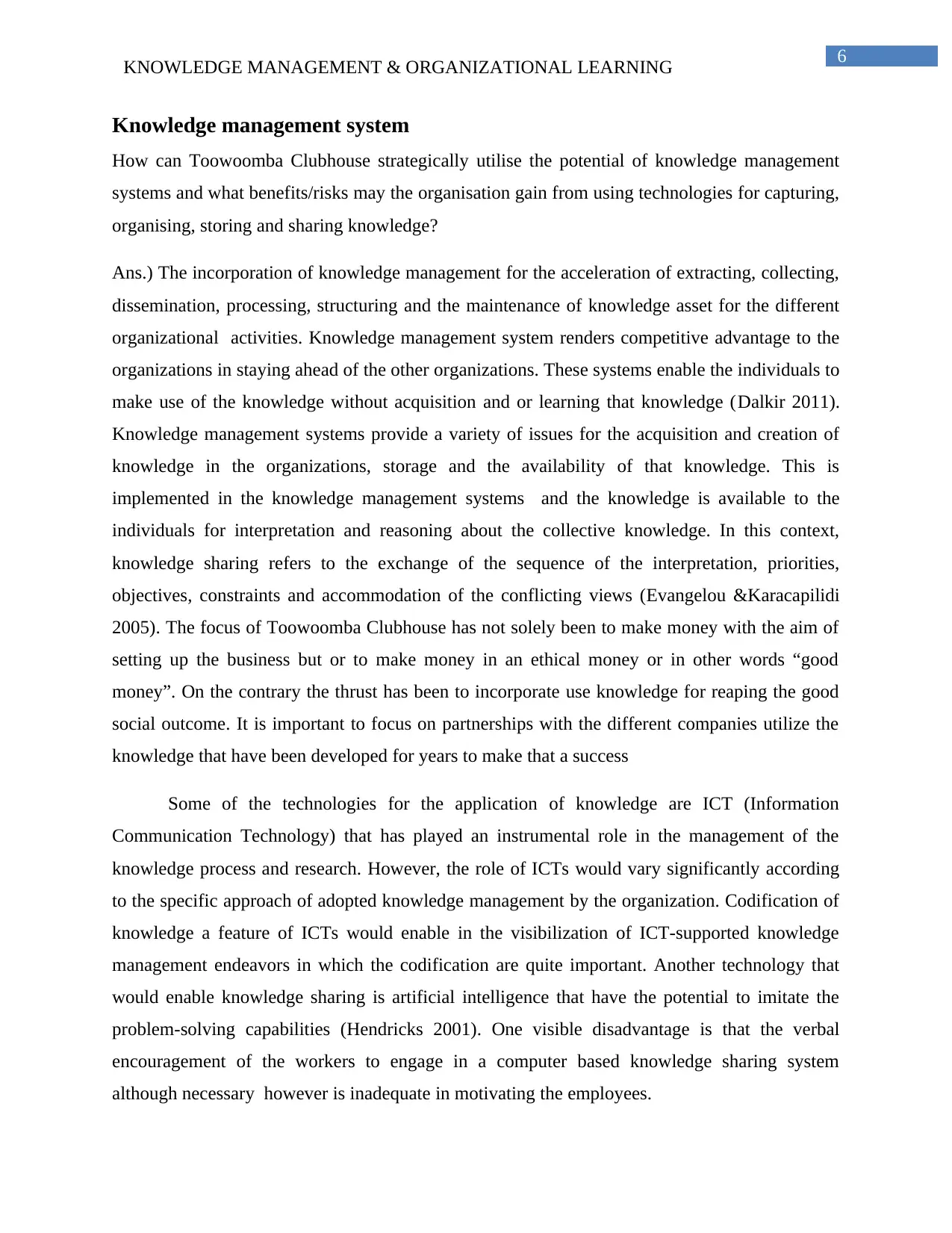
6
KNOWLEDGE MANAGEMENT & ORGANIZATIONAL LEARNING
Knowledge management system
How can Toowoomba Clubhouse strategically utilise the potential of knowledge management
systems and what benefits/risks may the organisation gain from using technologies for capturing,
organising, storing and sharing knowledge?
Ans.) The incorporation of knowledge management for the acceleration of extracting, collecting,
dissemination, processing, structuring and the maintenance of knowledge asset for the different
organizational activities. Knowledge management system renders competitive advantage to the
organizations in staying ahead of the other organizations. These systems enable the individuals to
make use of the knowledge without acquisition and or learning that knowledge (Dalkir 2011).
Knowledge management systems provide a variety of issues for the acquisition and creation of
knowledge in the organizations, storage and the availability of that knowledge. This is
implemented in the knowledge management systems and the knowledge is available to the
individuals for interpretation and reasoning about the collective knowledge. In this context,
knowledge sharing refers to the exchange of the sequence of the interpretation, priorities,
objectives, constraints and accommodation of the conflicting views (Evangelou &Karacapilidi
2005). The focus of Toowoomba Clubhouse has not solely been to make money with the aim of
setting up the business but or to make money in an ethical money or in other words “good
money”. On the contrary the thrust has been to incorporate use knowledge for reaping the good
social outcome. It is important to focus on partnerships with the different companies utilize the
knowledge that have been developed for years to make that a success
Some of the technologies for the application of knowledge are ICT (Information
Communication Technology) that has played an instrumental role in the management of the
knowledge process and research. However, the role of ICTs would vary significantly according
to the specific approach of adopted knowledge management by the organization. Codification of
knowledge a feature of ICTs would enable in the visibilization of ICT-supported knowledge
management endeavors in which the codification are quite important. Another technology that
would enable knowledge sharing is artificial intelligence that have the potential to imitate the
problem-solving capabilities (Hendricks 2001). One visible disadvantage is that the verbal
encouragement of the workers to engage in a computer based knowledge sharing system
although necessary however is inadequate in motivating the employees.
KNOWLEDGE MANAGEMENT & ORGANIZATIONAL LEARNING
Knowledge management system
How can Toowoomba Clubhouse strategically utilise the potential of knowledge management
systems and what benefits/risks may the organisation gain from using technologies for capturing,
organising, storing and sharing knowledge?
Ans.) The incorporation of knowledge management for the acceleration of extracting, collecting,
dissemination, processing, structuring and the maintenance of knowledge asset for the different
organizational activities. Knowledge management system renders competitive advantage to the
organizations in staying ahead of the other organizations. These systems enable the individuals to
make use of the knowledge without acquisition and or learning that knowledge (Dalkir 2011).
Knowledge management systems provide a variety of issues for the acquisition and creation of
knowledge in the organizations, storage and the availability of that knowledge. This is
implemented in the knowledge management systems and the knowledge is available to the
individuals for interpretation and reasoning about the collective knowledge. In this context,
knowledge sharing refers to the exchange of the sequence of the interpretation, priorities,
objectives, constraints and accommodation of the conflicting views (Evangelou &Karacapilidi
2005). The focus of Toowoomba Clubhouse has not solely been to make money with the aim of
setting up the business but or to make money in an ethical money or in other words “good
money”. On the contrary the thrust has been to incorporate use knowledge for reaping the good
social outcome. It is important to focus on partnerships with the different companies utilize the
knowledge that have been developed for years to make that a success
Some of the technologies for the application of knowledge are ICT (Information
Communication Technology) that has played an instrumental role in the management of the
knowledge process and research. However, the role of ICTs would vary significantly according
to the specific approach of adopted knowledge management by the organization. Codification of
knowledge a feature of ICTs would enable in the visibilization of ICT-supported knowledge
management endeavors in which the codification are quite important. Another technology that
would enable knowledge sharing is artificial intelligence that have the potential to imitate the
problem-solving capabilities (Hendricks 2001). One visible disadvantage is that the verbal
encouragement of the workers to engage in a computer based knowledge sharing system
although necessary however is inadequate in motivating the employees.
Paraphrase This Document
Need a fresh take? Get an instant paraphrase of this document with our AI Paraphraser
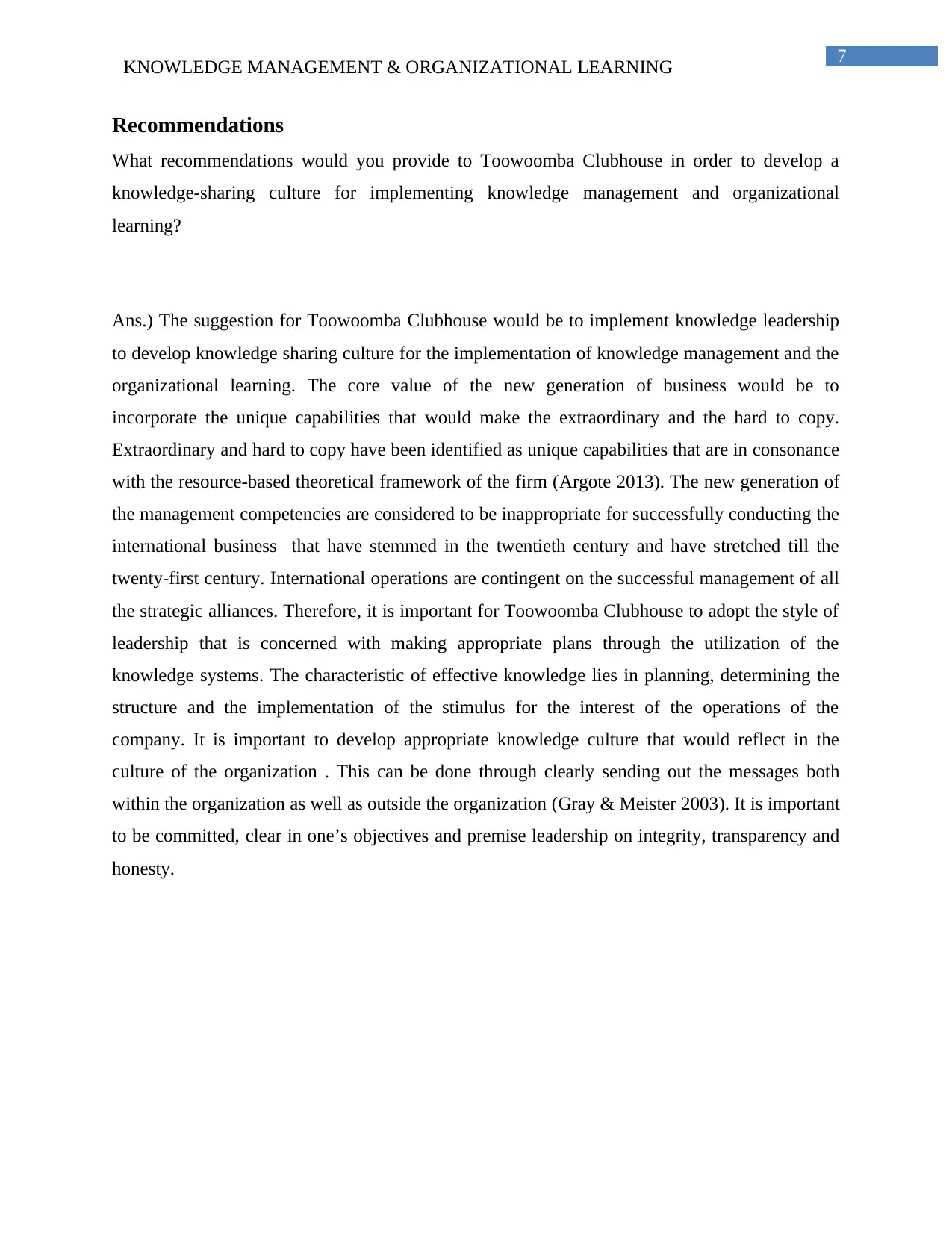
7
KNOWLEDGE MANAGEMENT & ORGANIZATIONAL LEARNING
Recommendations
What recommendations would you provide to Toowoomba Clubhouse in order to develop a
knowledge-sharing culture for implementing knowledge management and organizational
learning?
Ans.) The suggestion for Toowoomba Clubhouse would be to implement knowledge leadership
to develop knowledge sharing culture for the implementation of knowledge management and the
organizational learning. The core value of the new generation of business would be to
incorporate the unique capabilities that would make the extraordinary and the hard to copy.
Extraordinary and hard to copy have been identified as unique capabilities that are in consonance
with the resource-based theoretical framework of the firm (Argote 2013). The new generation of
the management competencies are considered to be inappropriate for successfully conducting the
international business that have stemmed in the twentieth century and have stretched till the
twenty-first century. International operations are contingent on the successful management of all
the strategic alliances. Therefore, it is important for Toowoomba Clubhouse to adopt the style of
leadership that is concerned with making appropriate plans through the utilization of the
knowledge systems. The characteristic of effective knowledge lies in planning, determining the
structure and the implementation of the stimulus for the interest of the operations of the
company. It is important to develop appropriate knowledge culture that would reflect in the
culture of the organization . This can be done through clearly sending out the messages both
within the organization as well as outside the organization (Gray & Meister 2003). It is important
to be committed, clear in one’s objectives and premise leadership on integrity, transparency and
honesty.
KNOWLEDGE MANAGEMENT & ORGANIZATIONAL LEARNING
Recommendations
What recommendations would you provide to Toowoomba Clubhouse in order to develop a
knowledge-sharing culture for implementing knowledge management and organizational
learning?
Ans.) The suggestion for Toowoomba Clubhouse would be to implement knowledge leadership
to develop knowledge sharing culture for the implementation of knowledge management and the
organizational learning. The core value of the new generation of business would be to
incorporate the unique capabilities that would make the extraordinary and the hard to copy.
Extraordinary and hard to copy have been identified as unique capabilities that are in consonance
with the resource-based theoretical framework of the firm (Argote 2013). The new generation of
the management competencies are considered to be inappropriate for successfully conducting the
international business that have stemmed in the twentieth century and have stretched till the
twenty-first century. International operations are contingent on the successful management of all
the strategic alliances. Therefore, it is important for Toowoomba Clubhouse to adopt the style of
leadership that is concerned with making appropriate plans through the utilization of the
knowledge systems. The characteristic of effective knowledge lies in planning, determining the
structure and the implementation of the stimulus for the interest of the operations of the
company. It is important to develop appropriate knowledge culture that would reflect in the
culture of the organization . This can be done through clearly sending out the messages both
within the organization as well as outside the organization (Gray & Meister 2003). It is important
to be committed, clear in one’s objectives and premise leadership on integrity, transparency and
honesty.
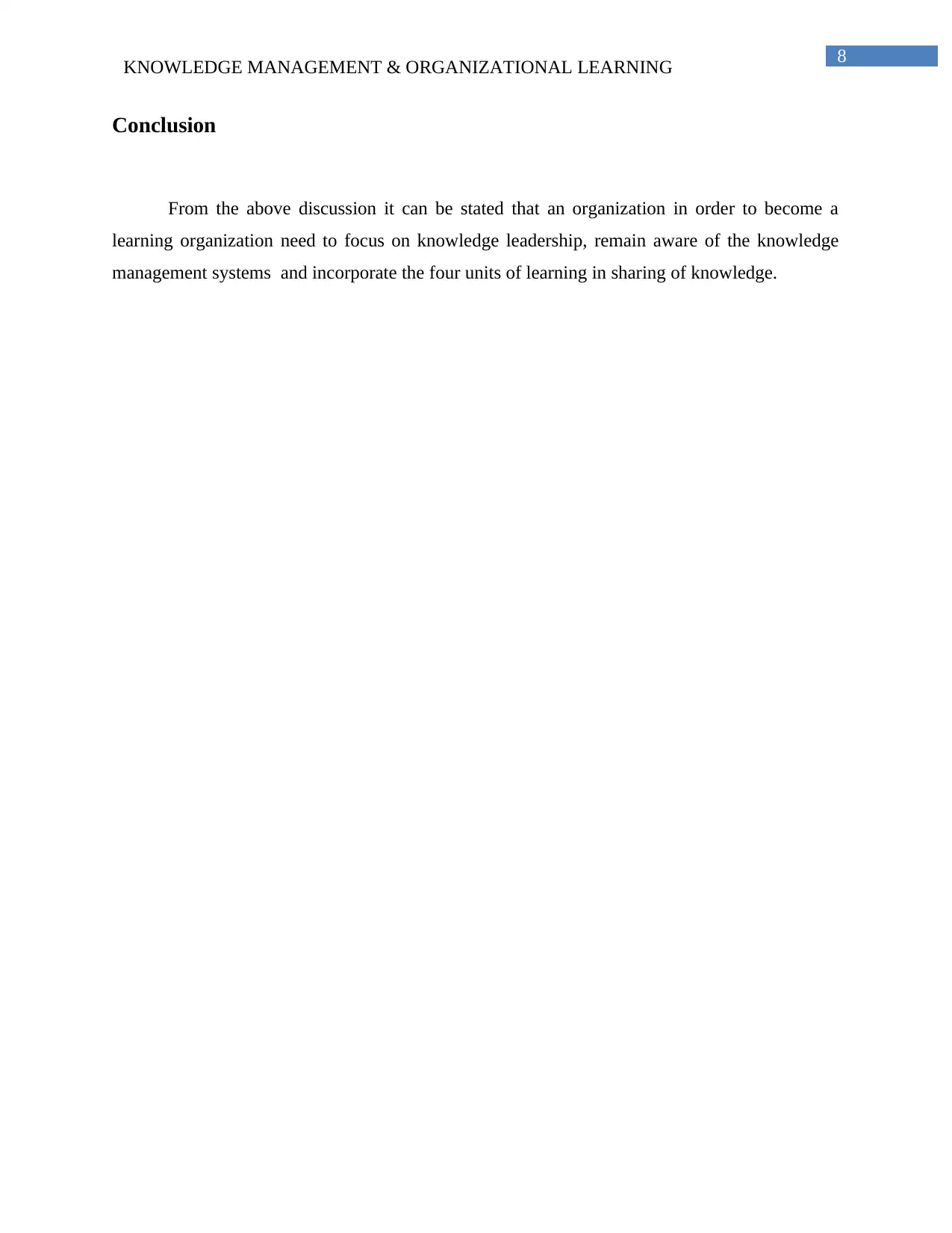
8
KNOWLEDGE MANAGEMENT & ORGANIZATIONAL LEARNING
Conclusion
From the above discussion it can be stated that an organization in order to become a
learning organization need to focus on knowledge leadership, remain aware of the knowledge
management systems and incorporate the four units of learning in sharing of knowledge.
KNOWLEDGE MANAGEMENT & ORGANIZATIONAL LEARNING
Conclusion
From the above discussion it can be stated that an organization in order to become a
learning organization need to focus on knowledge leadership, remain aware of the knowledge
management systems and incorporate the four units of learning in sharing of knowledge.
⊘ This is a preview!⊘
Do you want full access?
Subscribe today to unlock all pages.

Trusted by 1+ million students worldwide
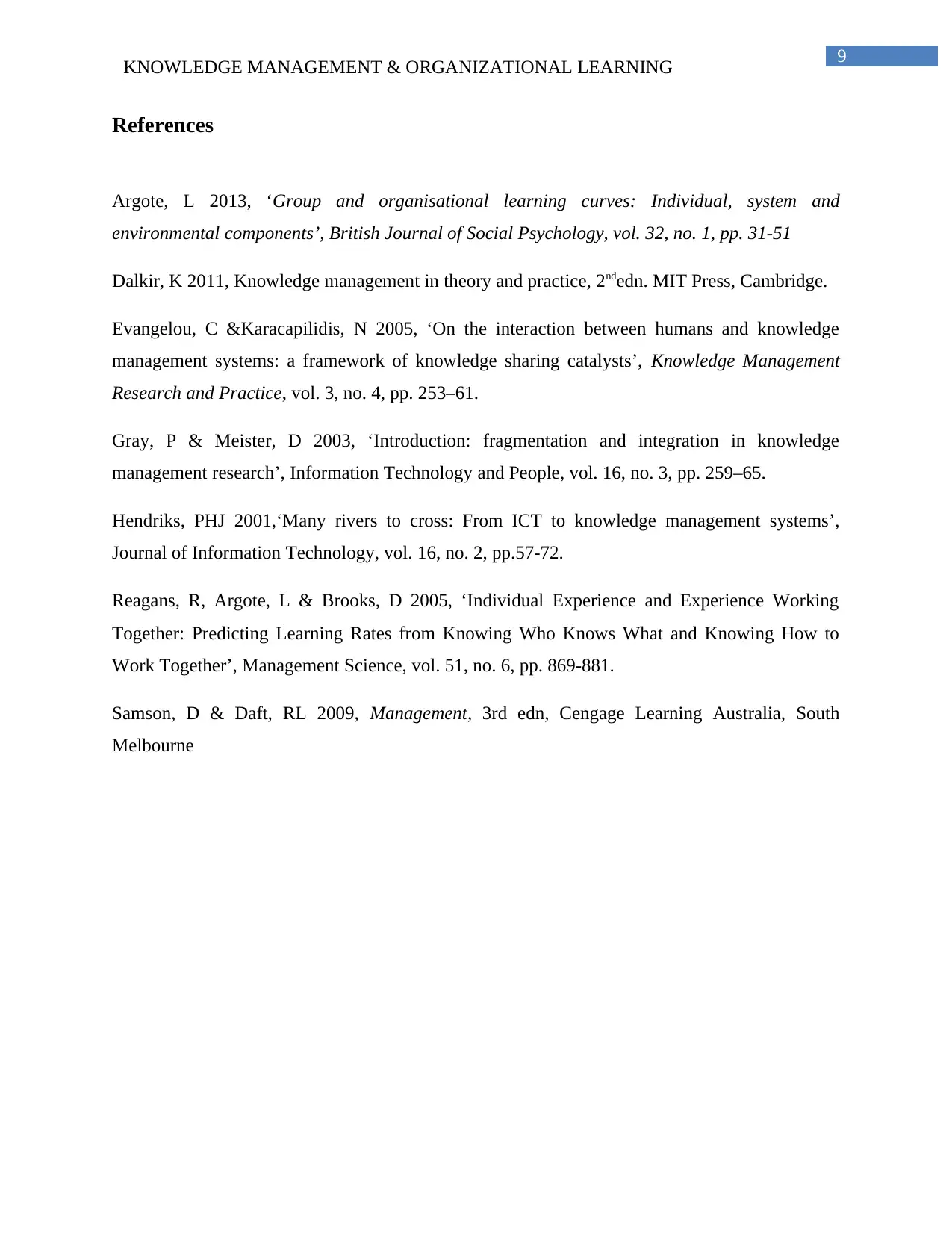
9
KNOWLEDGE MANAGEMENT & ORGANIZATIONAL LEARNING
References
Argote, L 2013, ‘Group and organisational learning curves: Individual, system and
environmental components’, British Journal of Social Psychology, vol. 32, no. 1, pp. 31-51
Dalkir, K 2011, Knowledge management in theory and practice, 2ndedn. MIT Press, Cambridge.
Evangelou, C &Karacapilidis, N 2005, ‘On the interaction between humans and knowledge
management systems: a framework of knowledge sharing catalysts’, Knowledge Management
Research and Practice, vol. 3, no. 4, pp. 253–61.
Gray, P & Meister, D 2003, ‘Introduction: fragmentation and integration in knowledge
management research’, Information Technology and People, vol. 16, no. 3, pp. 259–65.
Hendriks, PHJ 2001,‘Many rivers to cross: From ICT to knowledge management systems’,
Journal of Information Technology, vol. 16, no. 2, pp.57-72.
Reagans, R, Argote, L & Brooks, D 2005, ‘Individual Experience and Experience Working
Together: Predicting Learning Rates from Knowing Who Knows What and Knowing How to
Work Together’, Management Science, vol. 51, no. 6, pp. 869-881.
Samson, D & Daft, RL 2009, Management, 3rd edn, Cengage Learning Australia, South
Melbourne
KNOWLEDGE MANAGEMENT & ORGANIZATIONAL LEARNING
References
Argote, L 2013, ‘Group and organisational learning curves: Individual, system and
environmental components’, British Journal of Social Psychology, vol. 32, no. 1, pp. 31-51
Dalkir, K 2011, Knowledge management in theory and practice, 2ndedn. MIT Press, Cambridge.
Evangelou, C &Karacapilidis, N 2005, ‘On the interaction between humans and knowledge
management systems: a framework of knowledge sharing catalysts’, Knowledge Management
Research and Practice, vol. 3, no. 4, pp. 253–61.
Gray, P & Meister, D 2003, ‘Introduction: fragmentation and integration in knowledge
management research’, Information Technology and People, vol. 16, no. 3, pp. 259–65.
Hendriks, PHJ 2001,‘Many rivers to cross: From ICT to knowledge management systems’,
Journal of Information Technology, vol. 16, no. 2, pp.57-72.
Reagans, R, Argote, L & Brooks, D 2005, ‘Individual Experience and Experience Working
Together: Predicting Learning Rates from Knowing Who Knows What and Knowing How to
Work Together’, Management Science, vol. 51, no. 6, pp. 869-881.
Samson, D & Daft, RL 2009, Management, 3rd edn, Cengage Learning Australia, South
Melbourne
1 out of 10
Related Documents
Your All-in-One AI-Powered Toolkit for Academic Success.
+13062052269
info@desklib.com
Available 24*7 on WhatsApp / Email
![[object Object]](/_next/static/media/star-bottom.7253800d.svg)
Unlock your academic potential
Copyright © 2020–2025 A2Z Services. All Rights Reserved. Developed and managed by ZUCOL.
![Leadership Development Action Plan - [University Name] - [Semester]](/_next/image/?url=https%3A%2F%2Fdesklib.com%2Fmedia%2Fimages%2Fex%2Fca941d1709ed4555af6e8d6457548699.jpg&w=256&q=75)




